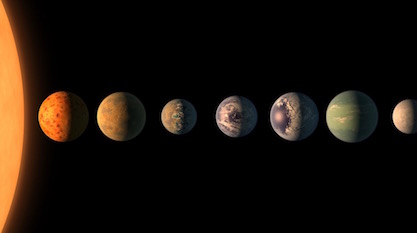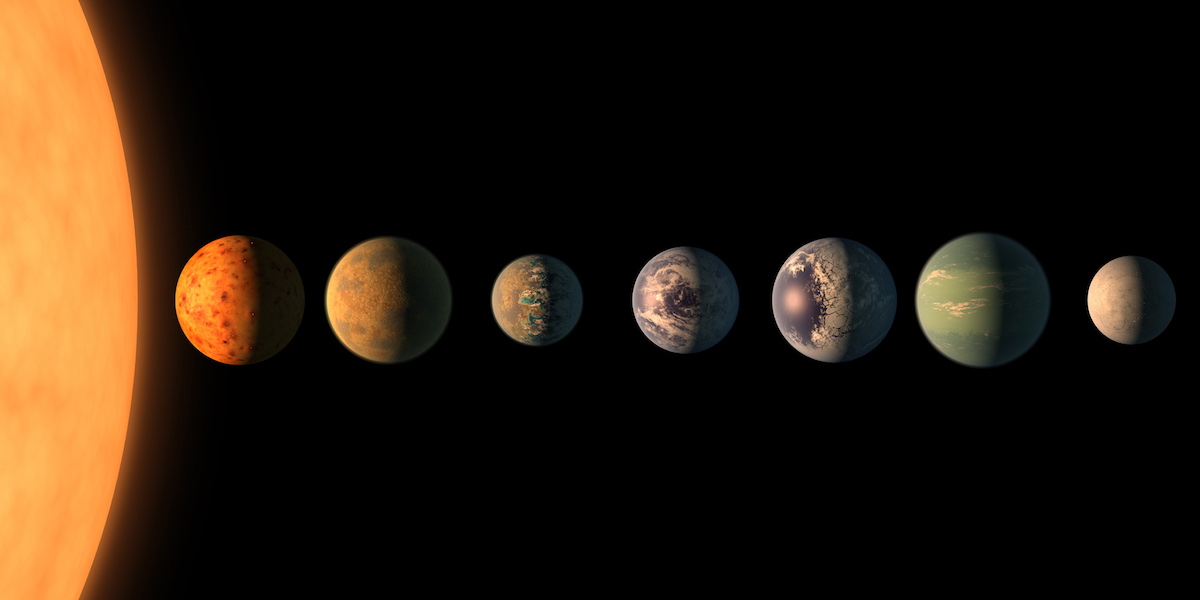 Evolution
Evolution
 Life Sciences
Life Sciences
 Physics, Earth & Space
Physics, Earth & Space
Remember Those Exciting “Earth-Like” Planets of the TRAPPIST-1 System? The Honeymoon Is Over


Do you recall the hubbub only one month ago about TRAPPIST-1, a dim red dwarf star some 40 light years from Earth? This star has seven planet, three of which, roughly Earth-sized, were announced as being potentially habitable. This led to excited speculation about alien evolution:
- “Nasa’s ‘holy grail’: Entire new solar system that could support alien life discovered” (The Independent)
- “Seven Alien ‘Earths’ Found Orbiting Nearby Star” (National Geographic)
Well, not so fast. Much of the breathlessness about the system stemmed from a thoroughly imaginative artist’s rendering courtesy of NASA. The planets are designated by letters, b through h. The middle three planets are depicted as rather inviting, with what appear to be pleasing Earth-like oceans.
Today, the TRAPPIST-1 bubble looks to have popped, with 3D computer climate modeling showing major problems with the system. According to Eric T. Wolf of the University of Colorado’s Laboratory for Atmospheric and Space Physics, the inner three planets would be barren, the outer three frozen. And the middle, planet e? In NASA’s rendering, it looks the most Earth-like. However, in a system like this centering on a dim red dwarf, planet e would need to have been stocked, to start, with seven times the volume of Earth’s oceans.
Cosmos Magazine cites Dr. Wolf’s paper post at arxiv.
“Model results indicate that the inner three planets presently reside interior to the inner edge of the traditional liquid water habitable zone,” he writes in a paper lodged on pre-print site arxiv.
“Thus if water ever existed on the inner planets, they would have undergone a runaway greenhouse and lost their water to space, leaving them dry today.”
The outer three planets, he adds, “fall beyond the maximum CO2 greenhouse outer edge of the habitable zone” and will have entered a lifeless snowball state.
Thus, only the middle planet remains a candidate for hosting life. It could maintain “at least some habitable surface”, Wolf notes, depending on the atmospheric nitrogen levels. If the planet is, in fact, covered in ocean, then “near present day Earth surface temperatures can be maintained”.
However, even one habitable planet may turn out to be a forlorn hope. Ultracool dwarf stars, Wolf says, may take as long as one billion years to settle into a stable system, during which orbiting planets are exposed to intense solar radiation, producing extreme greenhouse conditions. If this was the case with Trappist-1, then for the middle planet to retain abundant water today it would have to originally held seven times the ocean volume of Earth.
Materialists must have alien life, to assure themselves that Earth’s biology is nothing special, easily replicable by unguided evolutionary processes many other places in the cosmos. It seems unlikely the planets around TRAPPIST-1 support life, which means they cannot support evolutionary speculation, either.
Now it’s time to sit back and wait for the next half-baked “Earth-like” exoplanet to be wheeled out onstage by the popular science media. Don’t worry, it won’t be long.
Image credit: NASA/JPL-Caltech.
